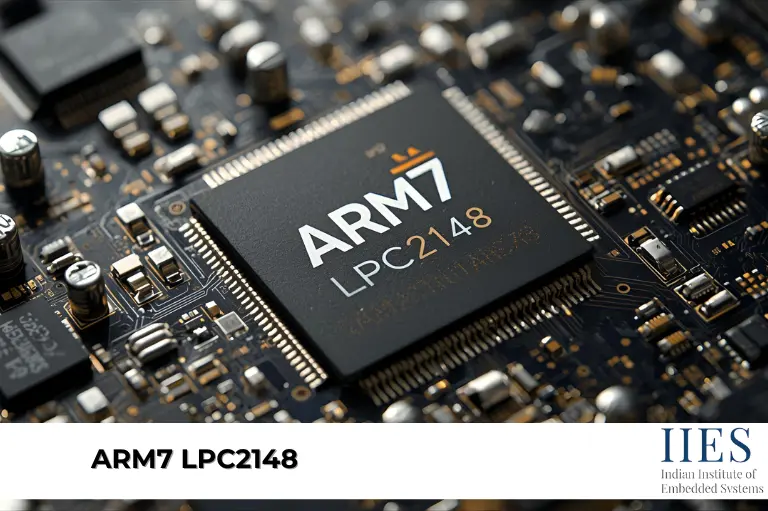
The ARM7 LPC2148 microcontroller is a popular 32-bit processor from NXP Semiconductors, widely used in embedded system courses in Bangalore, IoT devices, and electronic projects. Known for its high performance, low power consumption, and versatile features, it provides an excellent foundation for students, beginners, and professionals who want to design efficient embedded solutions.
Its small size and rich set of peripherals make it suitable for a wide range of real-world applications. From industrial automation to smart devices,the LPC2148 features provide the flexibility developers need to build innovative projects.
The microcontroller is also well-documented and supported by a strong developer community. This makes it a great choice for learning, experimenting, and creating solutions that connect theory with practical theory with practical embedded course in Bangalore training
The ARM7 LPC2148 is a 32-bit microcontroller from NXP with flash memory, SRAM, USB, and versatile I/O ports, making it reliable for embedded and IoT applications.
The ARM7 LPC2148 microcontroller architecture bridges traditional ARM designs and modern Cortex processors. Its small size, low power needs, and strong processing capabilities make it suitable for a wide range of applications—from industrial automation to smart devices.
NXP Semiconductors designed the LPC2148 with developers in mind, offering excellent documentation, global support, and community-driven resources. This makes it a favorite for both academic learning and real-world projects in embedded institute in Bangalore.
The LPC2148 features offer a balance between performance and simplicity. It comes with essential features like high-speed flash memory, built-in SRAM, USB support, and multiple I/O options. These features make it powerful enough for real-world products while still being easy for beginners to learn. Overall, it provides a strong foundation for both academic and industrial projects.
These features make the ARM7 LPC2148 development board flexible and future-ready for projects that require speed, reliability, and real-time execution.
The LPC2148 architecture based on the ARM7TDMI-S core, which supports both ARM and Thumb instruction sets. This dual instruction capability helps in optimizing speed and memory usage. It also integrates essential peripherals like ADC, DAC, UART, and timers, which make it highly versatile. Its simple design combined with advanced debugging support makes it an ideal choice for embedded applications.
Memory is one of the core strengths of the ARM7 LPC2148 microcontroller datasheet. It comes with flexible on-chip flash memory that supports in-system programming and in-application programming. Along with flash, it includes SRAM for temporary data storage and execution. This combination ensures developers can run programs efficiently while also storing large amounts of data securely.
The ARM7 LPC2148 microcontroller widely used across industries because of its reliable performance and low power consumption. From automotive control systems to IoT devices, it can handle a variety of tasks. Its built-in peripherals make it useful in robotics, smart devices, and consumer electronics. For students, it is often used in academic projects that focus on real-time control and embedded programming.
For students and hobbyists, it’s also one of the best choices for academic projects like:
For students and beginners, the LPC2148 is one of the best microcontrollers to start with. It is cost-effective, widely available, and supported by excellent documentation. Its features make it versatile enough to cover basic as well as advanced concepts in embedded systems. Learning this microcontroller helps in building a strong base for moving on to more powerful ARM Cortex processors.
If you’re starting in embedded system courses in Bangalore, mastering the ARM7 LPC2148 microcontroller architecture is highly beneficial.
The ARM7 LPC2148 microcontroller is a compact, reliable, and feature-rich device that continues to be a favorite in embedded systems and IoT projects. With its versatile memory, strong processing power, and beginner-friendly learning curve, it bridges the gap between classroom experiments and industrial applications. Whether you’re a student, hobbyist, or professional, mastering the LPC2148 opens the door to exciting possibilities in embedded design
LPC2148 is used in embedded systems, IoT devices, robotics, and real-time monitoring projects.
It offers ARM7TDMI-S core, USB support, flash memory, SRAM, and versatile I/O ports.
LPC2148 uses ARM7TDMI-S architecture supporting both ARM and Thumb instruction sets.
It has up to 512 KB Flash memory and 32 KB SRAM for program and data storage.
Yes, it is ideal for academic, industrial, and hobbyist embedded system projects.
It can be programmed using JTAG, UART/ISP, or In-Application Programming (IAP).
Indian Institute of Embedded Systems – IIES